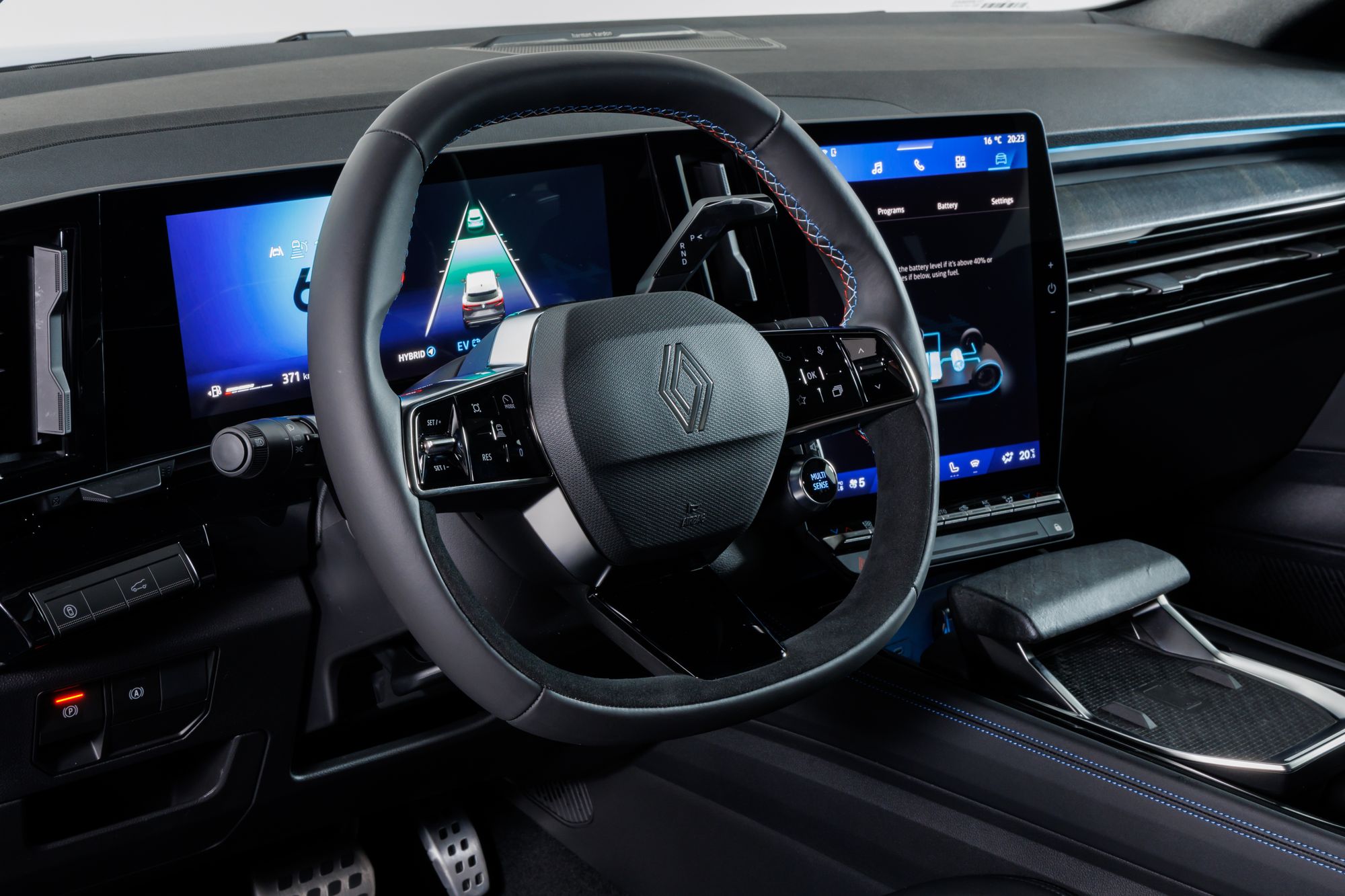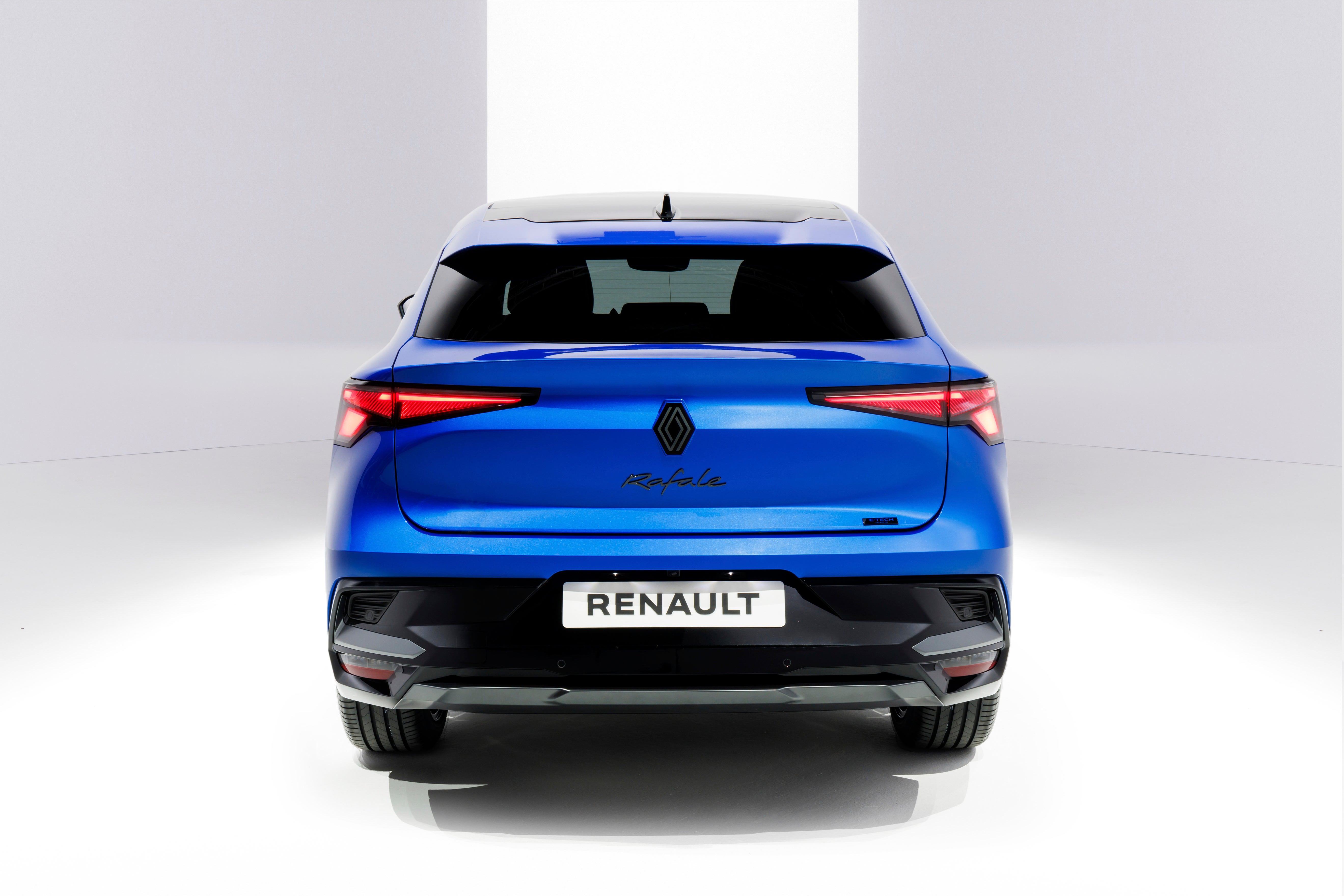
The new Renault Rafale E-Tech 4x4 300HP might just be one of the best-looking plug-in hybrids on sale today. It’s the sportier sibling to the Renault Austral – more coupe-like in profile, more grown-up in size, and a whole lot more potent under the skin.
Where many rivals lean on cautious styling, Renault’s gone full haute couture. From the rakish roofline to the dramatic LED lighting and chiselled Alpine-inspired nose, this is a family SUV with flair. But there’s substance to match the style, too – especially if you opt for the all-wheel-drive 300HP plug-in hybrid version tested here.
With a large 22kWh battery, a 1.2-litre turbocharged petrol engine and a trio of electric motors, it offers up to 62 miles of pure-electric driving – comfortably more than most plug-ins. That’s enough to cover the vast majority of daily journeys without using a drop of petrol, assuming you plug in regularly.
And plug in you should, because this is where the Rafale really makes sense. Charge at home overnight using cheap electricity, and your running costs plummet. With fuel prices still high, that matters more than ever.
This is a car that blends electric driving habits with long-haul flexibility – up to 621 miles on a full battery and tank, says Renault. Add in a high-tech cabin, a commanding driving position and smart suspension, and it’s a compelling package. But it’s not perfect…
How we tested
I drove the Renault Rafale E-Tech 4x4 300HP for a week across typical British roads: A-roads, suburban commutes, shopping runs, and a few sneaky backroad blasts, all to get a real-world feel for its electric range, tech, comfort and family-friendliness.
Renault Rafale: From £43,995, renault.co.uk

Independent rating: 7/10
- Pros: Striking design, great real-world electric range, high-tech Google infotainment, decent performance, four-wheel steering
- Cons: Cramped rear headroom, bumpy ride, some cheap interior bits, pricey versus Chinese rivals
Renault Rafale Specs
- Price range: £43,995 to £46,995
- Battery size: 22kWh
- Maximum EV range: 62 miles
- Engine: 1.2-litre 3-cylinder turbo petrol
- Claimed battery & engine range: Around 621 miles
Battery, range, charging, performance and drive
The Rafale’s plug-in hybrid system feels properly modern. It pairs a 1.2-litre turbocharged engine with three electric motors – one at the front, one at the rear for all-wheel drive, and a starter-generator. Together, they produce a meaty 300hp, helping the Rafale sprint from 0–62mph in 6.4 seconds.
But the real story is the battery. At 22kWh, it’s almost double what you get in many plug-in rivals – which translates to a genuinely useful 60+ miles of EV range in everyday conditions. That’s not just a box-ticking figure; I comfortably matched it on commutes and shorter runs, even with the air-con on.
Charging is decent too. A 7.4kW home wallbox will take the battery from empty to 100% in under 3 hours – ideal for overnight top-ups.
The drive is mostly quiet and smooth. In EV mode, the Rafale glides serenely through town, while the switch to petrol power is seamless if you’re gentle. Push harder and the transition can feel a bit hesitant, but it’s never noisy or jarring.
What’s more impressive is how manoeuvrable it feels for a big SUV. Four-wheel steering is standard, making tight turns and parking genuinely easy. The ride isn’t the best, though – on rougher roads it can feel a bit bouncy, even in comfort mode.
Sport mode adds some weight to the steering but doesn’t really transform the drive. The Rafale is best when you’re taking things at a more leisurely pace, although that lumpy ride never really goes away.

Interior, practicality and boot space
Renault’s interiors have taken a big step up recently and the Rafale continues the trend. You’re greeted by a portrait-style Google-powered touchscreen that dominates the dash, backed up by a crisp digital driver display. It’s modern, quick to respond, and familiar to anyone used to Google Maps.
There’s a clean design aesthetic throughout, especially in the top-spec Atelier Alpine trim, which adds cool blue detailing and sporty seats. Most materials feel good, though not everything is up to premium standards. The controls on the steering wheel feel a bit plasticky and are oddly placed – not helped by the fact there are three separate stalks sprouting from the right-hand side of the wheel for gear selection, wipers and audio. It’s too much.
Practicality is decent, if not class leading. Front seat space is generous, and the driving position is comfortable. The back seats offer decent legroom, but the low roofline makes it feel dark and slightly claustrophobic in the rear – taller teens might complain.
The boot is a decent size and not too compromised by the hybrid gubbins, though not quite as massive as boxier rivals. It’ll take a weekly shop and the usual family detritus without fuss.
The central console is functional but dominated by a large grab handle that feels more style than substance – not a deal-breaker, but it gets in the way more often than it helps.

Technology, stereo and infotainment
This is one area where the Rafale really shines. The Google-based infotainment system is superb – intuitive, voice-responsive, and packed with clever touches like predictive hybrid energy use based on route topography. It’s the same system used in the latest Megane E-Tech and Austral, but here it’s had a polish.
There’s built-in Google Maps, Google Assistant and Google Play apps – and it integrates seamlessly with your smartphone via wireless Android Auto or Apple CarPlay. OTA (over-the-air) updates come as standard, futureproofing the system without a dealer visit.
Higher trims get a head-up display and customisable drive modes, as well as clever regenerative braking adjustability via paddles behind the wheel – a neat touch that lets you control how strong the regen is.
The standard stereo is decent, though not class leading. An upgraded sound system (expected on Atelier Alpine trims) adds some extra punch and clarity – especially welcome when streaming your playlists over Bluetooth.
All in, this feels like a properly tech-savvy car – right down to predictive suspension that scans the road ahead and adjusts the damping accordingly.

Prices and running costs
At a starting price of £43,995, the Rafale PHEV isn’t cheap – and in top Atelier Alpine spec it’ll cost you nearly £47,000. That puts it in direct competition with plug-in offerings from the likes of Kia and Peugeot, and even a few base-spec BMWs and Audis.
Where it fights back is efficiency. With a 22kWh battery and caimed figures of 403.5mpg and 15g/km CO2, company car drivers should see attractive Benefit-in-Kind (BiK) rates.
There’s no £2,500 EV grant for PHEVs anymore, but Renault is offering competitive low-rate finance. Plug in at home using off-peak electricity, and running costs are seriously low.
As ever, this is a car that only makes sense financially if you make the most of its plug-in credentials – charge it often and you’ll save plenty. Ignore the cable, and you’re just lugging around extra weight.
Renault Rafale rivals
- Peugeot 408 Hybrid
- Kia Sportage PHEV
- Volkswagen Tiguan
FAQs
How long does the Rafale PHEV take to charge?
Just under 3 hours to 100% using a 7.4kW home charger.
Is it worth the money?
If you plug in regularly and want a stylish, efficient SUV with proper EV range, yes. But at nearly £44k, there are value-packed rivals – particularly from China.
Does Renault cover the battery?
Renault offers an 8-year battery warranty alongside its standard vehicle.
Why trust us
Our team of motoring experts have decades of experience driving, reviewing and reporting on the latest EV cars, and our verdicts are reached with every kind of driver in mind. We thoroughly test drive every car we recommend, so you can be sure our verdicts are honest, unbiased and authentic.
The verdict
Stylish and efficient, the Rafale is a welcome new face in the plug-in hybrid SUV space. It looks great, drives quietly and has a real-world electric range many rivals can’t match. But some ergonomic quirks, a few cheaper bits inside, a lumpy ride and pricing that edges into premium territory leave it just short of perfection.
Audi Q7 review: Big, beefy and practical, but on the expensive side
Geely EX5 review: Sensational value SUV with a little help from Lotus
Best used electric cars 2025: Top 10 second-hand EVs to buy
Best electric cars 2025: Top 12 EVs to buy
Should you buy a second-hand Tesla Model 3? This is our verdict after living with one
The Independent EV Price Index October 2025
Suzuki e Vitara review: Bags of charm, but behind the times on tech
Audi Q7 review: Big, beefy and practical, but on the expensive side







